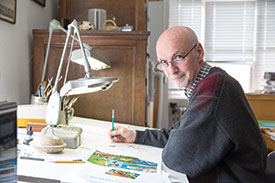John Megahan’s office in the Museum of Zoology is indicative of the man who works there.
Filing cabinets full of fish illustrations share space with bookshelves lined with biology textbooks, and his work desk is covered in kneaded erasers, paint brushes and microscopes. As the scientific illustrator and artist for the Department of Ecology and Evolutionary Biology, which includes the Museum of Zoology and the U-M Herbarium, Megahan straddles the art and science spheres.

Photo by Austin Thomason, Michigan Photography.
A scientist and artist by training (he received his master’s in marine biology and studied both fine arts and biology as an undergraduate), he was passionate about both fields. “I would sit there doodling in my lab books, but I also really enjoyed my time in the field. I had to figure out what I loved the most, what I was best at.” Megahan set out after graduate school to try his luck as an illustrator and never looked back.
He came to U-M in 1996 as a scientific illustrator, but now Megahan works on a variety of projects. He splits his time between doing illustrations for EEB faculty, working on sketches of species for the museum, creating art for conceptual projects, and designing and maintaining the EEB website. “My favorite kind of work is when I can do an illustration that brings in ideas from various aspects and seeing how they interact,” says Megahan, who recently did an illustration that described the migration of several bird species and how their viruses are transmitted along those migration lines.
Megahan didn’t study graphic design and web design before coming to U-M, but took classes at Washtenaw Community College in the late 1990s so he could build his skill set. “That seemed to be the direction that things were heading, so I learned how to code, and it becomes second nature after a while — kind of like learning another language.” He now codes the EEB website and creates graphics for upcoming events.
Although he enjoys web design, Megahan’s favorite task is still illustration. He draws the artwork for many biology books, and is careful to make sure that he’s accurate. “I focus on the message I’m trying to convey, and what the biologist needs. That means exact fin counts, scale counts — it can be a lot of fun.”
Megahan is also part of the group Artists for Conservation, which is made up of 500 artists from around the world whose art sales benefit environmental organizations. They host an annual art competition, and last year, Megahan entered a painting of a gyrfalcon, based on a picture he took at the Renaissance Fair several years ago. “For that painting, and whenever I do one, I like to have no distractions whatsoever; I just focus. Hours can go by and I’m just sitting there drawing. It’s easy to lose yourself in the work.”
When he’s not creating art, Megahan likes to cycle and play the fiddle. He also enjoys teaching; he’s taught art classes as an adjunct professor at the Penny W. Stamps School of Art & Design and runs a short illustration course at the University of Oregon in the summers.
The weekly Spotlight features faculty and staff members at the university. To nominate a candidate, please contact the Record staff at [email protected].

